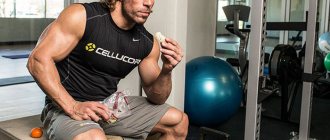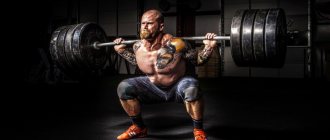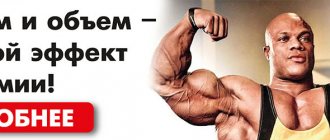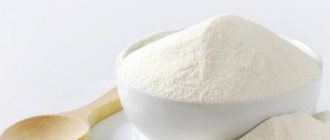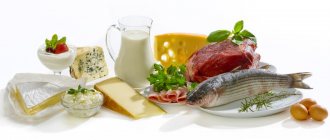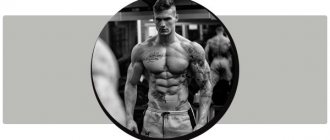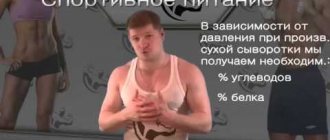Share:
In the new material we will touch upon the most important issue of modern athleticism, namely: is it possible to gain weight and cut at the same time? The opinions of endocrinologists, nutritionists and trainers differ in this regard. There are both successful examples of simultaneous cutting and gaining muscle mass, and unsuccessful ones. Let’s dig deeper to understand this topic in as much detail as possible.
Answer to the question
Before reading all the subsequent material, let’s give an immediate answer: simultaneous gain of muscle mass and cutting is, in principle, impossible for one simple reason: these are opposite processes.
Gaining muscle mass is an increase in anabolic levels, which stimulates super recovery in the body. While drying, especially the component that is responsible for fat burning, is an optimization catabolic process, in most cases it is forced for athletes.
BUT this does not mean that you cannot combine these processes. For all these tricks there is such a term as macro- and microperiodization.
Macroperiodization and microperiodization
It all depends on the construction of nutritional and training complexes. The usual cycle includes macroperiodization. What is its essence? It's quite simple - one step forward, one step back. Then two steps forward and one step back. First, we all gain muscle mass, and at the same time we gain glycogen reserves and, alas, body fat.
With proper training and nutrition planning, the set goes as follows:
- 200-300 g of muscle mass. The set depends on the level of metabolism and the level of the hormone testosterone - a direct stimulator of muscle protein synthesis.
- 500-1000 g of glycogen. Here everything is limited by the size of the glycogen depot. Thus, experienced athletes can gain up to 3 kg of glycogen per cycle.
- 1-3 liters of water. Since water is the main transport for all types of substances in our body, 3 liters of water per cycle is a systematic norm.
- 1-2 kg of adipose tissue.
Pure muscle mass accounts for about 10% of the total gain, or even less. Next, after several strength and mass-gaining cycles, athletes begin a drying period.
During the drying process (especially intensive), the following consumption occurs:
- 50-70 g muscle mass.
- 100-300 g of glycogen.
- 2-4 liters of water.
- 2-5 kg of adipose tissue.
Note: the so-called vacuum situations are considered above - i.e. with ideal adherence to the daily regimen, proper nutrition and training aimed at targeted fat burning.
After taking a few steps forward, the athlete takes a step back. In classic bodybuilding, periodization allows you to maintain the maximum amount of muscle mass, while losing as much body fat as possible. On average, using the classic system - 9 months of mass gain versus 3 months of cutting - the athlete receives a cumulative increase of up to 3 kg of pure muscle mass, and up to 20 kg of glycogen (it all depends solely on the characteristics of the body and the period).
Often the body fat becomes smaller than before the start of intense exercise.
With such periodization, simultaneous gain of muscle mass and drying is possible only during training, when the body intensively loses excess fluid, and super-recovery processes continue to stimulate the growth of protein tissue. However, the overall increase will be insignificant even when scaling this process for 1 month.
Conclusion: any classic athlete who does not use anabolic steroids will say that you cannot cut and gain muscle mass at the same time.
Now let's move on to microperiodization. This approach is used by athletes who engage in martial arts. After all, they need to constantly increase their speed and strength indicators, but at the same time maintain the same mass throughout the year.
The principles of microperiodization are almost identical to macroperiodization - only the period changes:
- Over the course of 3 weeks, you intensively gain muscle mass and glycogen reserves, trying to build metabolic processes in such a way that the overall increase in body fat is minimal.
- Then, in the 4th week, you begin a sharp transition to carbohydrate alternation or any other periodization diet. Being in its limit, you waste a huge amount of body fat.
- At the end of the month, you get the preservation of fat mass at the same level (a small gain or loss will be a statistical error), which is compensated by a gain of pure muscle mass.
Will such a result be noticeable in the short term? No! Will it be noticeable in the long term? Yes!
Whether this is considered simultaneous cutting and gaining muscle mass is another question. If we consider each period separately, then we cannot talk about simultaneous processes. But if we look at it in terms of macroperiodization, the answer is obvious... You have lost body fat and gained muscle mass.
An “old school” approach to bulking and cutting
Many have received similar recommendations more than once: “If you want to pump up big muscles, first go through a mass-gaining cycle - build a base for several months and eat everything you see, and preferably more - you should not put 2300 kcal into yourself, which is your norm for maintaining weight, and much more - 3500-4000 kcal.
When you gain at least 15-20 kg of mass, start cutting - do cardio often, increase the number of repetitions (“this way you will work for relief”), sharply reduce the amount of carbohydrates and fats, leaning on protein and vegetables.”
All over the world, old school mass gain has turned into the meme “Don’t worry - I’m on mass!”
Indeed, at first glance, this old-school scheme, described in the famous text “Sect of Jocks,” should work and, in general, it does, but it seems so only until you try this method on yourself. In this material we will talk about the disadvantages of the traditional approach of changing periods of mass collection and drying and present a modern, more competent strategy for changing cycles.
First, let's try to define each of the cycles:
The “mass” cycle is a period of time aimed at maximizing the fastest increase in muscle size and strength through training, subject to an excess of calories. (Since readers of Zozhnik have long known that you cannot grow muscles with a calorie deficit).
The “cutting” cycle is a period of time aimed at getting rid of the fat layer as quickly as possible while maintaining the muscle mass gained during the mass-gain period due to a calorie deficit.
Biochemical processes
Now let's talk about rationalizing microperiodization. Our metabolism is built on the principle of scales and strives for balance. Any impact on it, be it a change in the way we eat or a workout plan, is stress that our body resists.
When we influence the body, we strive to counteract the internal scales with external factors. This is how we gradually speed up our metabolism. Each time, more and more, we launch the principles of super-recovery and at the same time expand the glycogen depot. All this leads to a constant increase in strength indicators. Having reconfigured the scales, we practically do not encounter any counterweight from the body. This makes growth phenomenally fast.
This is especially noticeable in the first year of training, when a person, after the second month of training, begins a sharp increase in all indicators.
The same thing happens during drying - at first our body resists and strives to start optimization processes, but each time, succumbing to the trick, it burns fat and glycogen reserves faster and faster.
The body does not have time to get used to the current pace of exercise and diet. In fact, he does not know what will happen next - super recovery or extreme catabolism. Therefore, during microperiodization - after 2-3 months, progress stops completely. The body gets used to the type of load and to the periodization itself, maintaining the same balance. Consequently, the growth rate slows down.
Let's look at the numbers mentioned earlier
Using the classic system: 9 months of mass gain versus 3 months of cutting, the athlete receives a cumulative increase of up to 3 kg of pure muscle mass and up to 20 kg of glycogen.
In the case of microperiodization, an athlete, even if he follows all the basics in nutrition and training processes as competently as possible, will gain a maximum of kg of muscle mass and 5-6 kg of glycogen. Yes, it will be an immediate dry mass that will not require additional drying, but:
- Lean mass is highly influenced by diet. In case of violation of the regime, it is easy to lose the entire result for a month. At the same time, if there are large glycogen reserves and properly accelerated metabolism, losses in the event of a violation will amount to some crumbs.
- The cumulative increase is significantly lower.
- Microperiodization is much more difficult to maintain than macroperiodization.
- A complete stop of growth in all types of indicators is possible, which will entail adaptation. This is a strong psychological barrier. Any plateau is a powerful stress for an athlete and often leads him to think about quitting.
And most importantly: walking dry all the time is dangerous to your health. There are many examples of healthy and lean athletes simply dying due to the destabilization of all processes in the body.
Now, if you still haven't changed your mind, we'll look at how to effectively bulk and cut at the same time as part of microperiodization.
Sports nutrition
Ordinary high-calorie food is not a panacea. Eating so much every day is still difficult, and often simply impossible due to work, lack of time to cook, and so on. Sports nutrition successfully solves these problems.
Sports nutrition is actually a pure concentrated beneficial substance. Maximum required in minimum volume. The vast majority of athletes, be they weightlifters, bodybuilders or crossfitters, take sports nutrition, and beginners and amateurs should do the same.
Whey Protein
Protein sports nutrition helps you meet your daily protein intake, which averages 2 grams per kilogram of body. It is recommended to get 50% of your protein from regular food, and the remaining half from sports nutrition. Whey protein is the most effective. Take it 3-5 times a day: in the morning, immediately after sleep, and between meals.
Popular brands:
- Optimum Nutrition 100% Whey Gold Standard →
- Genetic Lab Whey Pro →
- Fit Foods Mutant Whey →
Gainer
If there is no weight gain, that is, if there is a lack of calorie intake, a gainer helps - a super-calorie mixture of carbohydrates and proteins. Take it immediately after training, and if you are unable to have a normal breakfast, take it in the morning.
Popular brands:
- Fit Foods Mutant Mass →
- Dymatize Nutrition Super Mass Gainer →
- Optimum Nutrition Serious Mass →
Pre-workout complex
Pre-workout supplements are supplements that help you exercise more efficiently. They include products to improve blood supply and muscle nutrition, substances that promote the growth of muscle strength and volume, vitamins and microelements.
Popular brands:
- APS Mesomorph →
- Finaflex Stimul8 →
- Gold Star Black Annis →
Creatine
Creatine is one of the most studied sports supplements with proven effectiveness in promoting muscle growth and strength. Take it on rest days, that is, when you do not train, 3-4 grams.
Popular brands:
- Dymatize Nutrition Creatine Monohydrate →
- Genetic Lab Creatine Powder →
- R-line Creatine →
Vitamin-mineral complex
A lack of vitamins and minerals is harmful in itself, and specifically when gaining weight, it additionally negatively affects muscle growth.
Popular brands:
- Optimum Nutrition Opti-Men →
- Universal Nutrition Animal Pak →
- Scitec Nutrition Jumbo Pack →
Diet planning
Let's look at the classic microperiodization system for simultaneous weight gain and fat burning:
| Phase | Phase time | Meal plan |
| Mass recruitment | 3 weeks | Moderate acceleration of metabolism - 4 meals a day. Calculation of the increase in calorie content is no more than 10% excess. The amount of protein per kg of net weight is about 2 g. Mostly slow carbohydrates. |
| Maintenance | 1 Week | Slowing metabolism - 2 meals a day. The increase in calorie content is 1-3% excess. The amount of protein is 0.5 g per kg of body. |
| Drying | 5-7 days | Moderate acceleration of metabolism - 6 meals a day. Calculation of calorie gain is no more than 20% of the deficit. The amount of protein per kg of net weight is about 4 g. Periodization within a weekly cycle is possible according to the principle of carbohydrate alternation. |
| Mass recruitment | 3 weeks | Moderate acceleration of metabolism - 4 meals a day. Calculation of the increase in calorie content is no more than 10% excess. The amount of protein per kg of net weight is about 2 g. Mostly slow carbohydrates. |
| Maintenance | 1 Week | Slowing metabolism - 2 meals a day. The increase in calorie content is 1-3% excess. The amount of protein is 0.5 g per kg of body. |
| Drying | 5-7 days | Moderate acceleration of metabolism - 6 meals a day. Calculation of calorie gain is no more than 20% of the deficit. The amount of protein per kg of net weight is about 4 g. Periodization within a weekly cycle is possible according to the principle of carbohydrate alternation. |
| Mass recruitment | 2 weeks | Moderate acceleration of metabolism - 4 meals a day. Calculation of the increase in calorie content is no more than 10% excess. The amount of protein per kg of net weight is about 2 g. Mostly slow carbohydrates. |
| Maintenance | 2 week | Slowing metabolism - 2 meals a day. The increase in calorie content is 1-3% excess. The amount of protein is 0.5 g per kg of weight. |
| Drying | 7-10 days | Moderate acceleration of metabolism - 6 meals a day. Calculation of calorie gain is no more than 20% of the deficit. The amount of protein per kg of net weight is about 4 g. Periodization within a weekly cycle is possible according to the principle of carbohydrate alternation. |
| Mass recruitment | 3 weeks | Moderate acceleration of metabolism - 4 meals a day. Calculation of the increase in calorie content is no more than 10% excess. The amount of protein per kg of net weight is about 2 g. Mostly slow carbohydrates. |
The cycle is designed for an ectomorph weighing from 70 kg with body fat up to 16%. It does not take into account the individual characteristics of training, nutrition, initial metabolic rate, testosterone levels, etc. At the same time, as an example of periodization within the framework of micro-changes in the cycle, it shows that you need to keep a food diary and clearly divide the diet into periods.
A maintenance period is needed so that, with accelerated metabolism after mass gain, you do not drain the muscles by switching to drying immediately. The optimal solution would be an additional supplement in the form of a maintenance cycle during the transition between drying and bulking. Yes, the effectiveness of such a diet will be minimal - the percentage of fat, as well as muscle mass, will increase slightly, in return you will get what you came for - a set of ideal lean muscle mass while simultaneously drying out the body.
We deliberately do not consider the issue of water consumption and consumption, as well as life hacks with the removal of excess salts, since we believe that in the long term this will cause more harm than good - especially for the heart muscle.
Training planning
After drawing up a diet, proceed to microperiodization of training complexes. Here everything is somewhat more complicated: although training is less important than diet, without it mass gain, a determining factor in the process of microperiodization, is impossible.
| Phase | Phase time | Workout |
| Mass recruitment | 3 weeks | Heavy circuit training - working the entire body at least once a week. The remaining workouts should be a systematic split, loading the largest muscle groups. It is important to maintain high intensity with an overall short training complex. |
| Maintenance | 1 Week | Mostly split. To slow down metabolism as much as possible, it is recommended to temporarily abandon basic complexes. We work small muscle groups. We completely refuse cardio exercises, including warm-up ones. For warming up, it is better to use stretching complexes. This is the perfect time to work on your abs. |
| Drying | 5-7 days | Exclusively cardio exercise. The training cycle should be a two-day split, working half the body per workout with basic exercises in pumping mode for blood signature and glycogen reduction. Avoid any heavy exercise. After each basic exercise, perform 2-3 isolating exercises. The total training time, including cardio, should be about 120-150 minutes. It is recommended to use 4-6 workouts per week to achieve optimal levels of fat loss. |
| Mass recruitment | 3 weeks | Heavy circuit training - working the entire body at least once a week. The remaining workouts should be a systematic split, loading the largest muscle groups. It is important to maintain high intensity with an overall short training complex. |
| Maintenance | 1 Week | Mostly split. To slow down metabolism as much as possible, it is recommended to temporarily abandon basic complexes. We work small muscle groups. We completely refuse cardio exercises, including warm-up ones. For warming up, it is better to use stretching complexes. This is the perfect time to work on your abs. |
| Drying | 5-7 days | Exclusively cardio exercise. The training cycle should be a two-day split, working half the body per workout with basic exercises in pumping mode for blood signature and glycogen reduction. Avoid any heavy exercise. After each basic exercise, perform 2-3 isolating exercises. The total training time, including cardio, should be about 120-150 minutes. It is recommended to use 4-6 workouts per week to achieve optimal levels of fat loss. |
| Mass recruitment | 2 weeks | Heavy circuit training - working the entire body at least once a week. The remaining workouts should be a systematic split, loading the largest muscle groups. It is important to maintain high intensity with an overall short training complex. |
| Maintenance | 2 week | Mostly split. To slow down metabolism as much as possible, it is recommended to temporarily abandon basic complexes. We work small muscle groups. We completely refuse cardio exercises, including warm-up ones. For warming up, it is better to use stretching complexes. This is the perfect time to work on your abs. |
| Drying | 7-10 days | Exclusively cardio exercise. The training cycle should be a two-day split, working half the body per workout with basic exercises in pumping mode for blood signature and glycogen reduction. Avoid any heavy exercise. After each basic exercise, perform 2-3 isolating exercises. The total training time, including cardio, should be about 120-150 minutes. It is recommended to use 4-6 workouts per week to achieve optimal levels of fat loss. |
| Mass recruitment | 3 weeks | Heavy circuit training - working the entire body at least once a week. The remaining workouts should be a systematic split, loading the largest muscle groups. It is important to maintain high intensity with an overall short training complex. |
Working out during this period is characterized by the same serious changes in periodization as during nutrition.
We must not forget about such important aspects as:
- Constant shock to the muscles. Do not use the same training exercises when changing complexes. Example: if in the first cycle of mass gain you used deadlifts and squats with a barbell behind your back, then in the second cycle of mass gain use the Romanian deadlift with a trap bar, supplementing it with a squat with a barbell on the front.
- Do not use more than 50% of a single approach during drying periods.
- Don't do interval cardio - it can burn a lot of muscle if you can't keep track of your heart rate zone.
- During the support period, you can completely abandon basic exercises. Do not train more than 3 times a week; training time should be about 30 minutes.
https://youtu.be/XT_U7u5j_oQ
Sportspit
As for sports nutrition supplements that are suitable for simultaneously gaining muscle mass and cutting within the limits of microperiodization, there are absolutely no secrets here.
- During the period of mass gain, use sports nutrition to gain mass.
- During the drying period, use sports nutrition for drying.
- During the maintenance period, use exclusively whey protein. A transition period is needed to remove excess creatine phosphate (in case you are overloaded with it) and prepare the body for a change in the course of drugs.
There are general recommendations that the editors recommend in case you decide to undertake such a serious experiment:
- Multivitamins - throughout the entire period. Don’t be afraid to get hypervitaminosis - during intensive drying, you will most likely reduce the amount of necessary micronutrients several times.
- BCAA - on an ongoing basis.
- Polymineral complexes. Look at the magnesium and zinc content that is most important in your case.
- Do not eliminate sodium completely during drying - leave a minimal amount for a more systematic entry and exit.
Track your progress
To track your progress during the mass gain period, you need to weigh yourself once a week, as well as take measurements and photo reports. Keep in mind that if after a week the scales show plus 300 grams, and your waist diameter has not increased, you have managed to find your golden mean. If you have added more than 300 grams on the scales and at the same time you notice an increase on your sides, then subtract about 250 kcal from your diet. By adjusting your caloric intake by +\- 250 kcal, you can control the gain in quality mass, while avoiding unnecessary increases in fat percentage.
And for the accuracy of the result, it is advisable to weigh yourself at the same time and under the same/similar circumstances.
Really effective remedy
Note: The following section is presented for informational purposes only. The editors are not responsible for possible damage to your body and do not advocate the use of AAS and other serious doping factors to achieve results.
Of course, in reality, everyone has been deceiving you all this time, including us! After all, a fitness instructor from a nearby gym goes dry all year round, while constantly building up a huge amount of muscle mass. He knows exactly the working method and is ready to advise you on a special product for a piece price. This drug is called anabolic steroids. Only with them you can simultaneously build muscle mass and dry out. And even with them, this process will not be particularly effective.
How does this happen? The thing is that if you choose the right course (from drugs that do not fill with water), you can increase protein synthesis even while drying.
The following medications and courses will help:
- Stanazol injection + Winstrol tablets. Both drugs have low conversion to estrogen and practically do not add water. They are often used during cutting to preserve muscle mass. But with constant use, they note that they have an anti-catabolic effect and have a slight fat-burning effect.
- Oxandrolone + testosterone propionate. The first is responsible for gaining lean mass, the second maintains the intensity of training during the cutting cycle.
Let us note right away: when working with hormonal drugs, completely different types of training complexes and diets are used. The principle of operation of these drugs is based on the fact that they force the body to synthesize protein (in the presence of building materials) even under conditions of external catabolic processes.
Extreme athletes can add growth hormone. It will cause hyperplasia, which in turn will increase the number of muscle fibers. This will in no way affect strength indicators, but will allow you to gain muscle mass even when following the most extreme and harmful mono-diets.
Important: If you decide to use AAS in your training, do not forget about the addictive effect, and most importantly, do not forget about the smooth entry and exit from the course with the advance use of post-course therapy drugs. Only in this case will you protect yourself from the appearance of gynecomastia, virilization or masculinization (for girls) .
Is it possible to create the body of your dreams at home?
Male trainers who claim that a sexy, toned body can only be created in the gym are completely wrong. This discourages many young mothers or those who do not have access to a gym from playing sports at all. It is much better to do feasible exercises at home than not to do them at all. Many girls are simply embarrassed to come to the gym, especially knowing that pumped up and fit beauties go there. So here it is. I can say with confidence that it is quite possible to tighten your body and dry it at home.
But for this you need to fulfill a number of conditions:
- training should be regular;
- you can choose a trainer on YouTube and perform video training;
- use sports equipment: jump rope, fitball, dumbbells, barbell, body bar, step, etc.;
- follow a diet and adhere to a diet;
- gradually increase the load and change the training plan;
- combine strength training, cardio exercises, and stretching.
And the most important thing! Remember that your nutrition and training system should become your lifestyle. Only then will the body have time to readjust and understand that fat reserves can be successfully replaced with muscle tissue.
And here is a practical training for drying the body for girls:
https://youtu.be/2TYU3-hCN_0
What about the girls?
Gaining muscle mass and cutting for girls is an issue that deserves special attention. The natural level of natural testosterone in women is several times lower. This means that microperiodization will not work at all. The maximum that can be earned in this case is problems with the endocrine system and metabolic disorders, which will then have to be treated separately.
It is better to use classical macroperiodization. If it is important for you to remain thin and slender throughout the year, use a cycle: a month of mass gain versus 3 months of low-intensity drying. Only in this case will you be able to maintain your “phytoshape” all year round, even without great achievements in sports.


